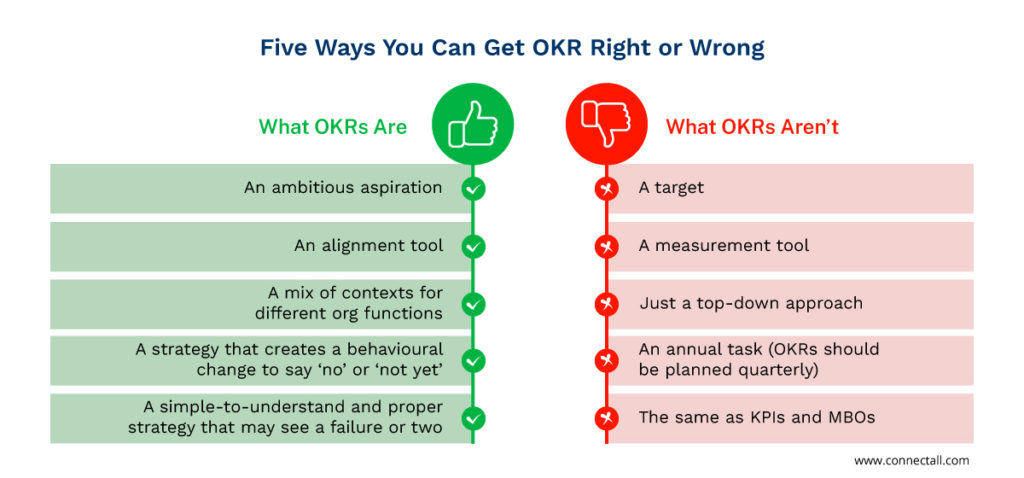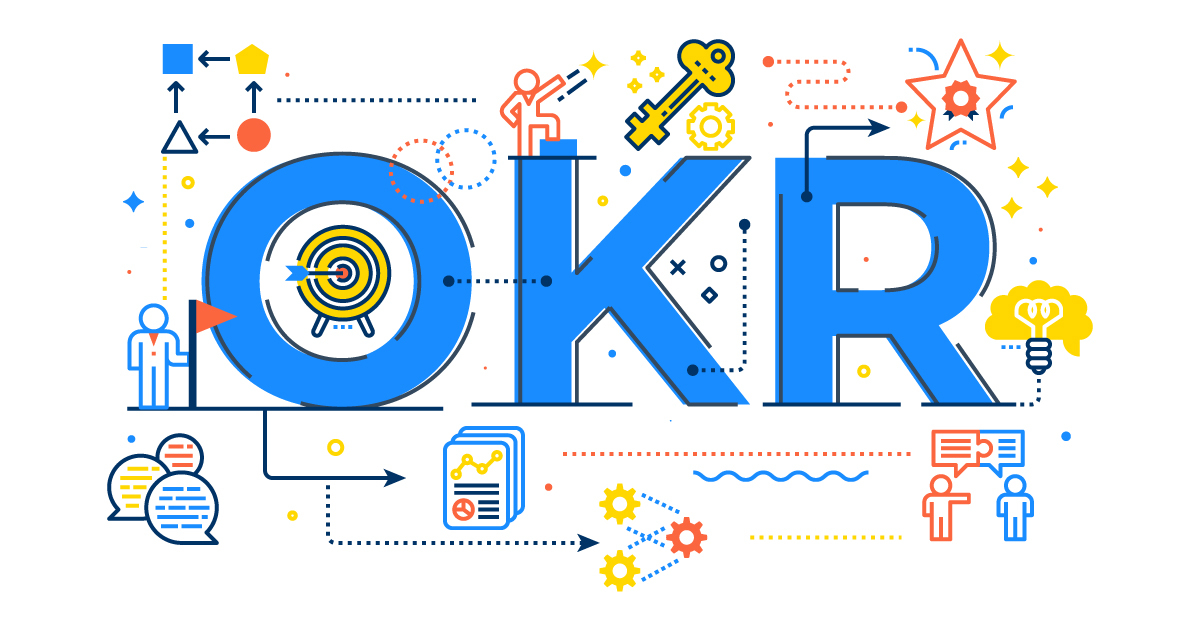Organizations that are constantly trying to scale their Lean and Agile practices and strategies to increase agility have to evolve the way progress is measured. This requires a strategic setting of objectives that can be measured accurately to track progress of the objectives. In an earlier blog post, titled Objectives and Key Results: Not Just a Means to an End for Businesses, I highlighted the need for OKRs for organizations practicing lean to measure the ongoing health of processes and align efforts up and down the organizational hierarchy around the most important improvement opportunities, and how there needs to be a shift to an outcomes-based thinking.
In this blog post, I will talk about how lean practices like Value Stream Management (VSM) and OKRs (Objectives and Key Results) complement each other to help organizations, especially the ones that are in a scaled-agile environment, achieve the larger goal of business outcomes, improve agility and velocity, become more predictable by delivering value, and focus on what matters.
OKR is all about setting objectives that can be tracked with key results. A lean practice like VSM is all about minimizing waste in the value stream and optimizing the software delivery value stream to deliver value. OKRs and VSM go hand-in-hand in their overarching goal: figuring out what really matters and getting that done in a time-bound, efficient manner so that it all improves performance.
How VSM and OKRs Can Complement Each Other
To understand this better, let’s first examine what each practice attempts to achieve on its own. You will notice instantly that VSM can help craft OKRs, while OKRs guides or boosts the intent of VSM. The similarities are stark!
| Value stream management | Objectives and Key Results |
|---|---|
| Specify what value means to an end customer for each product/service | An objective defines the clear value related to a context, theme, or mission |
| Identify the steps in the value stream for each product, eliminating the steps that do not create value | Key results work as evidence of progress or completion, with clear steps that are measurable, variable, and credible; OKRs that don’t have measurable value can be rewritten |
| Make the value-creating steps occur in tight sequence so the product/service will flow smoothly toward the customer | Measurable milestones which, if achieved, will advance objectives in a useful manner to the goals |
| Allows customers to gain value from upstream activities | As objectives are introduced, OKRs are cascaded into different departments or functions that take ownership for the key results and reap benefits from the outcomes |
| The creation of value, steps of value-creation, and improving and optimizing flow is continued until value is delivered with zero waste | As more OKRs are introduced on a quarterly basis, change is witnessed in all aspects of the organization, as well as in customer value |
VSM metrics, or lean metrics or even value stream KPIs, from a business standpoint, give leaders access to aggregate business intelligence with details like: changes to headcount, process and tooling; development cadence including planning, funding, releases or sprints; and metrics like process time, cycle time, lead time, flow time, wait time, value added time, MTTR, escaped defect ratio, WIP, blocker data, queues, throughput and production impact, etc.
The data-driven analytics that VSM triggers helps track an organization’s software and digital transformation journey to establish where it is today and how it can achieve the next level of development and delivery. This further enables lean budgeting that primarily focuses on early indicators of customer satisfaction. Lean budgeting, unlike traditional approaches, tends to view a business as a reasonably stable set of products or services that brings value to customers and a system of value streams through which it produces those products. Each of those customer-facing products or internal value streams is enabled by a cross-functional group of people who use processes and systems to get their job done. Because these value streams are continuous, we tend to measure them by analyzing trends.
The OKR process is one way that mature Lean-Agile organizations approach setting, communicating, and monitoring goals on a regular basis. Defining and aligning around OKRs helps to link organizational and team goals in a hierarchical way to measurable outcomes.
This allows an organization to pivot faster and spend money where the business has the most impact – based on value stream, agile release train (ART) and/or team OKRs. Without the guidance of OKRs, a particular value stream may end up using funds for something that doesn’t deliver the intended value the business needs, and subsequently, the organization cannot quickly release funds to something more innovative and in-line with what the market needs now.
Outlining Context is Important for OKR Implementation and Vice Versa
This is especially true for an organization practicing Lean and Agile. You can define, link, and leverage OKRs at every level and grow an organizational coherence from them. It helps create context and at the same time it also needs context to be implemented. Interesting, isn’t it?
There are several types of OKRs you can use. Three of them that stand out would be:
- outcome-based or portfolio OKRs
- output-based or feature OKRs
- program-based, or OKRs used by ART
It’s important to understand the difference between the three so that you may implement them effectively alongside VSM. A common mistake that companies make is to only follow a top-down approach with OKRs. Yet with OKR, there is no one-size-fits-all approach. You have a template and you have the knowledge of how OKRs would benefit you. As I mentioned in my earlier blog post, starting small would be ideal. The other mistake is to look at activities to achieve objectives as key results. The beauty about OKRs is that you may start anywhere in your software development or delivery setup, as long as you decide the intent or the context — that it is outcomes-, output-, or program-based, for example.
Outcome-based or portfolio OKR: Largely, outcomes would be a measurable change in users’ behaviour. Crystallize your strategic themes and investment objectives around OKRs, and embed OKRs in every portfolio epic. OKRs owned by the Portfolio should demonstrate the contribution of epics towards desired outcomes, and will help you with investment decision-making.
Output-based or feature OKR: This is to create an impact on the users’ behaviour because of a certain feature that was delivered. Establishing OKRs for each feature provides great discipline when articulating outcomes rather than solutions.
Program-based or ART-driven OKR: From the product management perspective, ARTs sometimes set OKRs for high-priority initiatives, which provide laser focus to product management.
We can go deeper into how OKRs can work for each of these contexts. But let’s park that for later. For now, what you need to understand is that some OKRs will be about value in the form of measurable, customer impact; others will be about improving flow by reducing lead time, reducing batch size, eliminating obstacles or changing the organizational structure to make it easier to get work done; and others will be about the sustainable elements such as people/team satisfaction, managing costs, reducing silos across different autonomous value streams, etc.
Like all other new management practices or acronyms, OKRs can also be misunderstood, misused and abused. To help you understand them better, here’s a complimentary guide to some interesting aspects of OKR.
Five Ways You Can Get OKR Right or Wrong
Objectives and Key Results are transparent, with measurable key results and tangible milestones. They allow everyone in the organization to see each other’s goals, from the CEO down to the newest intern. This enables an entire company to align their work toward the same overall goals.

If you enjoyed this blog post and want to understand more about any one or all types of OKRs, write to us and our team will help you.
“Get a free 30-minute consultation and evaluation with our Principal Solutions Architect Johnathan McGowan“

Head of Content Marketing at ConnectALL, responsible for communication and content marketing strategy. For two decades, I’ve assisted businesses to integrate content marketing into their marketing plans to achieve their business goals. I specialize in creating and developing content (inbound and outbound) across various online and offline channels from websites, blogs, and social media to email marketing and marketing communication collateral.


